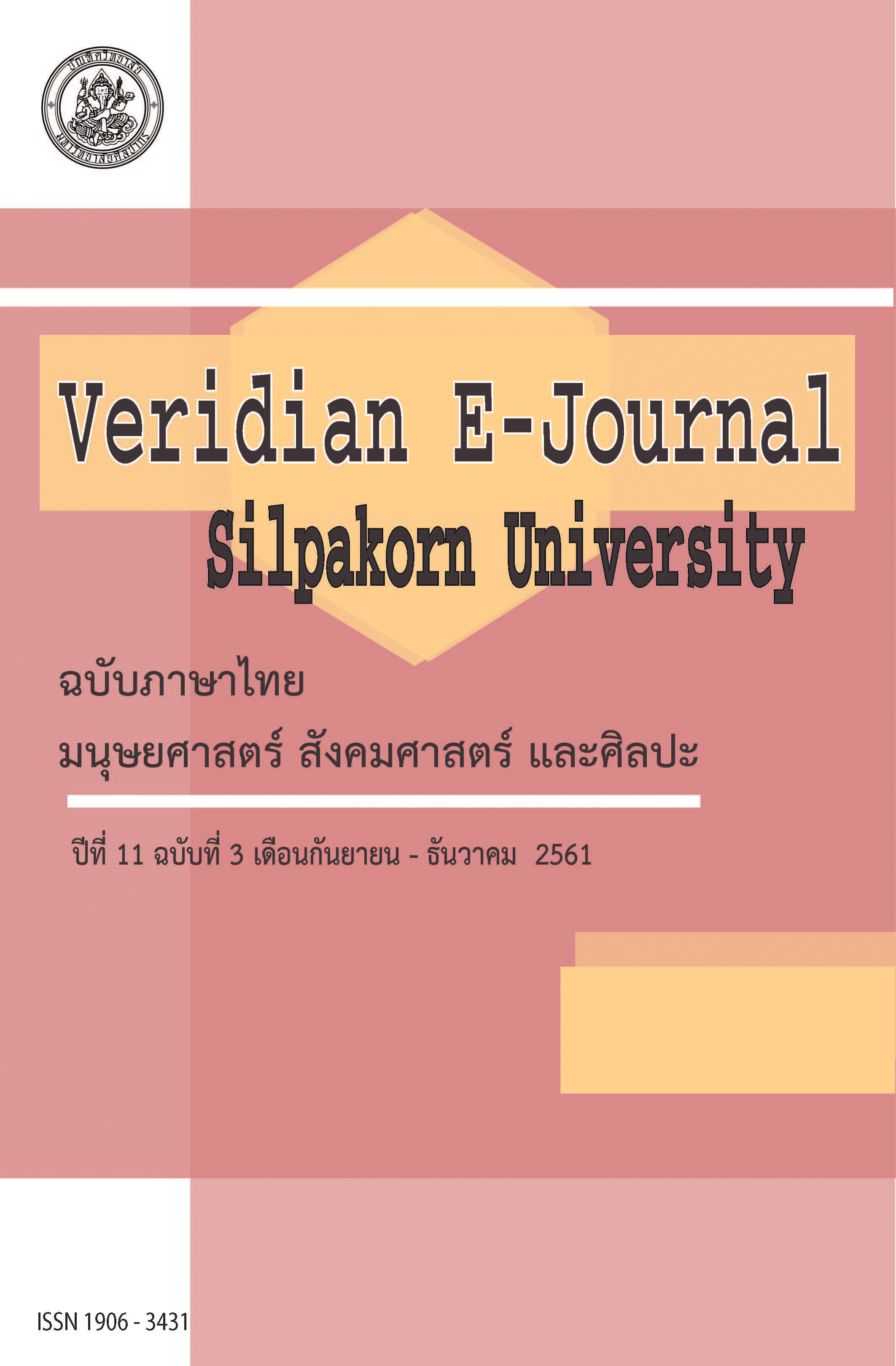ความรู้ ทัศนคติและพฤติกรรมการบริโภคผักและผลไม้ ของนักเรียนชั้นมัธยมศึกษาตอนต้น โรงเรียนสาธิตมหาวิทยาลัยศรีนครินทรวิโรฒ ประสานมิตร (ฝ่ายมัธยม) (Knowledge, Attitude and Consumption Behaviorof Vegetables and Fruits of Junior High School Students Srinakharinwirot University Prasanmit Demonstration School Secondary)
Main Article Content
Abstract
การศึกษาวิจัยเชิงสำรวจมีวัตถุประสงค์เพื่อศึกษาความรู้ ทัศนคติ และพฤติกรรมการบริโภคผักและผลไม้ ความสัมพันธ์ระหว่างความรู้และทัศนคติกับพฤติกรรมการบริโภคผักและผลไม้ของนักเรียนชั้นมัธยมศึกษาตอนต้น โรงเรียนสาธิตมหาวิทยาลัยศรีนครินทรวิโรฒประสานมิตร (ฝ่ายมัธยม) กลุ่มตัวอย่างคือ นักเรียนชั้นมัธยมศึกษาตอนต้น โรงเรียนสาธิตมหาวิทยาลัยศรีนครินทรวิโรฒ ประสานมิตร (ฝ่ายมัธยม) ที่กำลังศึกษาในภาคการศึกษาที่ 2 ปีการศึกษา 2560 ใช้วิธีการสุ่มกลุ่มตัวอย่างแบบหลายขั้นตอน (Multi-stage sampling) ได้กลุ่มตัวอย่างจำนวน 268 คน เครื่องมือที่ใช้คือแบบสอบถาม มีค่าความเชื่อมั่น 0.76 สถิติที่ใช้ในการวิเคราะห์ข้อมูล ได้แก่ ค่าความถี่ ค่าร้อยละ ค่าเฉลี่ย ค่าส่วนเบี่ยงเบนมาตรฐาน และค่าไคว์สแควร์ ผลการศึกษาพบว่า กลุ่มตัวอย่างส่วนใหญ่เป็น เพศหญิง (ร้อยละ 53.73) ได้รับความรู้เกี่ยวกับการบริโภคผักและผลไม้จากผู้ปกครองหรือญาติมากที่สุด โดยมีระดับความรู้เกี่ยวกับการบริโภคผักและผลไม้อยู่ในระดับดี (ร้อยละ 60.08) รองลงมาคือ ระดับปานกลาง (ร้อยละ 29.85) มีทัศนคติในการบริโภคผักและผลไม้ อยู่ในระดับปานกลาง ( = 3.28) ส่วนใหญ่มีพฤติกรรมการบริโภคผักผัดบ่อยครั้ง (ร้อยละ 8.64) รองลงมาคือผักสด (ร้อยละ 7.03) ชนิดของผักที่บริโภค 3 อันดับแรกคือ ข้าวโพด บล็อกโคลี่ และผักบุ้ง ส่วนพฤติกรรมการบริโภคผลไม้พบว่าบริโภคผลไม้แปรรูปมากที่สุด (ร้อยละ 10.95) รองลงมาคือ ผลไม้สด (ร้อยละ 9.37 ) ชนิดของผลไม้ที่บริโภค 3 อันดับแรกคือ แอปเปิ้ล องุ่น และกล้วย เหตุผลที่เลือกบริโภคผักและผลไม้ เพราะอร่อย (ร้อยละ 29.18 ) รองลงมาคือไม่มีกลิ่นเหม็น (ร้อยละ 23.51) ผลการทดสอบสมมติฐานพบว่า ความรู้มีความสัมพันธ์กับพฤติกรรมการบริโภคผักและผลไม้ ด้านความถี่ในการบริโภคผักแปรรูป ผลไม้แช่อิ่ม และผลไม้กวน อย่างมีนัยสำคัญทางสถิติที่ระดับ .05 และทัศนคติมีความสัมพันธ์กับพฤติกรรมการบริโภคผักและผลไม้ ด้านความถี่ในการบริโภคผักสด ผลไม้ดอง เหตุผลในการบริโภคผักและผลไม้ ชนิดของผักและผลไม้ที่บริโภค อย่างมีนัยสำคัญทางสถิติที่ระดับ .05 นอกนั้นไม่มีความสัมพันธ์กัน
This survey research is conducted to study about knowledge, attitude, consumption behavior of vegetables and fruits, and also the relationship between knowledge, attitude and consumption behavior of vegetables and fruits of junior high school students from Prasarnmit Demonstration Secondary School. In addition, the sample group is the junior high school students from Prasarnmit Demonstration Secondary School who are studying in second semester of the academic year 2018. By using multi-stage sampling method, there are 268 participants to be the sample group. The research instrument is the questionnaire, containing the reliability value with 0.76. The data were analyzed by using frequency, percentage, mean, standard deviation and Chi-square. The result shows that:
1) Most of participants are female (53.73 %)
2) The participants get the vegetables and food consumption knowledge from their parents or relatives the most.
3) The participants have the vegetables and food consumption knowledge at the high level (60.08%), followed by the medium level (29.85%).
4) The attitude towards the vegetables and food consumption is in medium level ( 3.28).
5) The participants mainly eat fried vegetables (8.64%) followed by fresh vegetables (7.03 %)
6) Top three for vegetable consumptions are corn, broccoli and morning glory.
7) The participants mainly eat processed fruits (with 10.95%), followed by fresh vegetables (9.37%)
8) Top three for fruit consumptions are apples, grapes, and bananas.
9) The reasons to consume fruits and vegetables are delicious (29.18%), followed by not having bad smell (23.51%)
The results of the hypothesis test showed that knowledge is related to fruits and vegetables consumption behavior with the frequency of the processed vegetables, preserved fruits, and fruit jam at the .05 significant level. Moreover, the attitude is related to fruits and vegetables consumption behavior with the frequency of the raw vegetables, preserved fruits, reasons to consume fruits and vegetables, and types of fruits and vegetables at the .05 significant level. The others are not in the relationship with attitude and knowledge.
